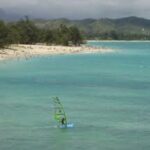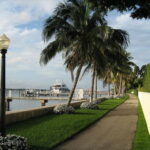New Hampshire’s coastline is all of 13.5 miles long, and for years, surfers have been calling this home. Weather does not matter to New England surf enthusiasts, who actually prefer the fall and winter, because there are less tourists in the water. They even surf when there is a foot of snow on the ground, due to state-of-the-art wetsuit technology.
Because of New Hampshire’s jagged coastline, this area is unique for surfing, in that there are numerous “point breaks,” where waves hit a rocky point that juts out from the shoreline. These waves break gradually, rather than all at one time, facilitating a longer ride. In total, there are 26 well-known surf spots with a mix of point breaks, reefs, and beach breaks.
Hampton Beach is the main beach, the most crowded, has the most tourists, so surfing is restricted in the summertime. The surfing vibe is alive here, and there is no scarcity of fun activities. Hampton Beach boasts a boardwalk, restaurants, hotels, bars, nightlife, shops, arcades, and plenty of surf shops that offer surf lessons. During the summer, there are free concerts at the Seashell Stage, fireworks, Monday night free movies on the beach, a Children’s Festival, and a Sand Sculpting Competition. September brings a Seafood festival, followed by the Harvest Moon Fall Festival in October.
For the surfers, there are specific sections of the beach that are designated surfing areas, so as not to compete with swimmers and sun worshippers. One of the best surf spots is a peninsula, called Boar’s Head, just off Hampton. Just north of here is North Hampton Beach, where you can see dozens of surfers lined up in wetsuits waiting to catch that perfect wave. Undoubtedly the very best spot is south of North Hampton Beach, a place called “the Wall,” which consistently has the best wave action in New Hampshire. It is a 15 minute paddle out to the Wall, and can be exhausting, depending on tides and currents.
Water temperatures in New Hampshire in the Fall are in the low 50’s, and surfers will be wearing 4/3 or 5/3 wetsuits. They are made of neoprene, which is a synthetic rubber elastic material with excellent insulating properties. They come in various thicknesses from 2-6mm, with the first number reflecting the thickness on the torso, and the second number reflecting the thickness of the suit on the extremities. In addition, most surfers wear booties, gloves, and hoods to protect from the cold northeast waters. The more the wetsuit hugs your body, the more effective it is to maintain warmth by letting less water in.
Surfers love the wave action, and New Hampshire’s beaches offer some of the best in New England. Check it out for yourself.






